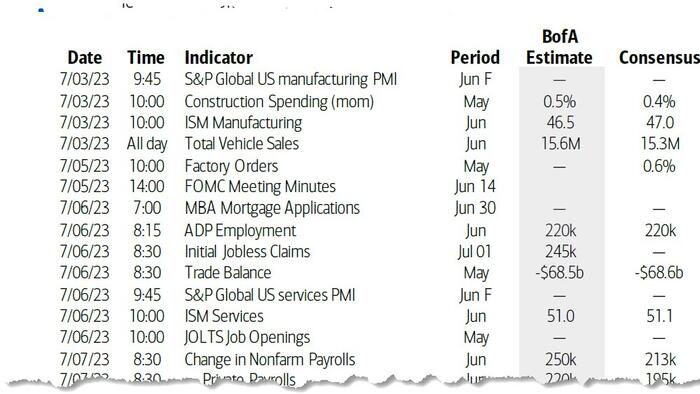


As we kick off July, US Independence Day tomorrow and an shortened Monday trading day will ensure a stop start week but it remains a big one with US payrolls (Friday) and the global PMIs and US ISMs through the week. May's JOLTS (one month behind), June's ADP and weekly claims (all Thursday) will give us a payrolls appetizer. Elsewhere according to DB's Jim Reid, the RBA (tomorrow) is seemingly a 50/50 call and staying with central banks, the Fed minutes are out on Wednesday with the ECB survey of consumer expectations the same day.
In terms of the key event, as usual in the first week of a new month the main event is Friday's payrolls. With the headline numbers ranging from +217k to +472k over the last 6 months, these are not currently close to recessionary levels (at least not until they are revised drastically lower). However, as Reid notes, the average recession through history has seen payrolls move from an average of just over +100k in the 3-6 months before to very suddenly negative in the first month of the recession where it tends to stay for several months. You don’t tend to get any warning from prior payroll prints that its going to turn negative but with the range this year, and last month being at +339k, we probably need to move down into the 100-200k range before we can be on more near-term recession watch. Even then it still might not happen but that’s probably a necessary condition outside of a shock.
For Friday, DB's economists expect headline (consensus +225k, DB +200k vs. +339k previously) and private (consensus +200k, DB +175k vs. +283k) payroll gains to slow relative to their three-month averages of +283k and +231k, respectively. This should still edge unemployment back down a tenth to 3.7% (consensus 3.6%) after a surprise spike last month. Hours worked was weak last month and DB's economists expect that to bounce from 34.3 to 34.4hrs. Hourly earnings are expected to be steady at 0.3%.
In terms of the US ISMs this week, today manufacturing index is expected to come in lower a 46.3 vs 46.9 last month, continuing a trend of all but one month being below 50 since November. Thursday's services ISM (consensus 51.3, vs, 50.3 last month) is expected to see a rebound from the second surprise stagnation print in the last 6 months. So put any rebound in some perspective. In addition the employment component in both ISMs may be used to fine-tune payroll predictions. The three-month average for the ISM manufacturing employment series stood at 49.5 as of May while that of services was 50.4, near the lows of the last cycle. So one to watch. Broadening the focus, various other global PMIs come through in the first half of the week.
Other notable indicators due include the US trade balance on Thursday and factory orders on Wednesday. A full summary of US events is below:
There will be plenty of activity in Europe as well. In Germany, these include the trade balance tomorrow, followed by factory orders on Thursday and industrial production on Friday. In France, investors will keep an eye on industrial production (Wednesday) and the trade balance (Friday) and, in Italy, PMIs (Monday and services on Wednesday) and retail sales (Friday) are out.
Apart from data, investors may also pay attention to OPEC's 8th International Seminar running on Wednesday-Thursday, with several CEOs and oil ministers expected among the speakers. With oil prices bouncing around $70/bbl amidst the lack of a demand catalyst, the focus will be on whether some OPEC+ members will again try to put a firmer floor under prices.
Here is a day-by-day calendar of events, courtesy of DB
Monday July 3
Tuesday July 4
Wednesday July 5
Thursday July 6
Friday July 7
Finally, looking at just the US, Goldman writes that the key economic data releases this week are the ISM manufacturing report on Monday, JOLTS job openings on Thursday, and the employment situation report on Friday. The minutes from the June FOMC meeting will be released on Wednesday and Fed presidents Williams and Logan have speaking engagements scheduled this week.
Monday, July 3
Tuesday, July 4
Wednesday, July 5
Thursday, July 6
Friday, July 7
Source: DB, Goldman, BofA

